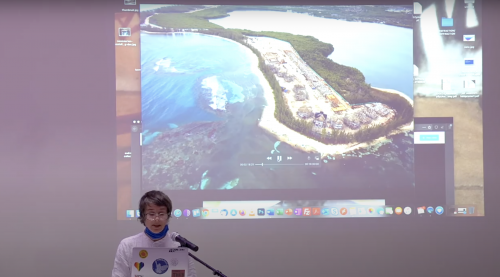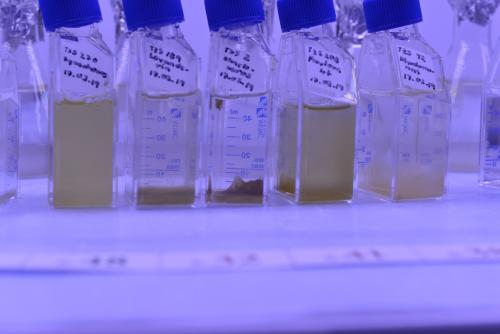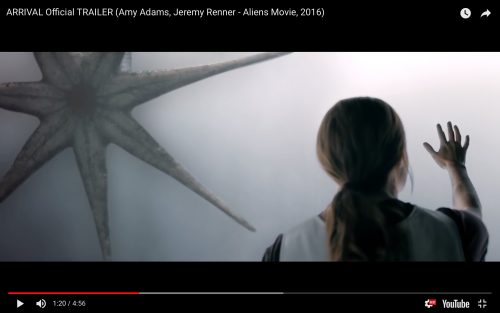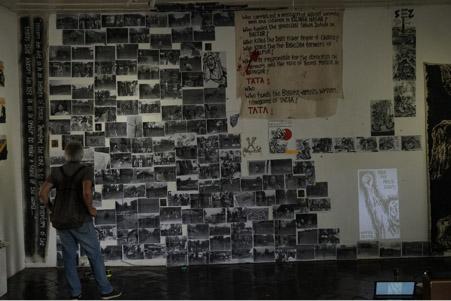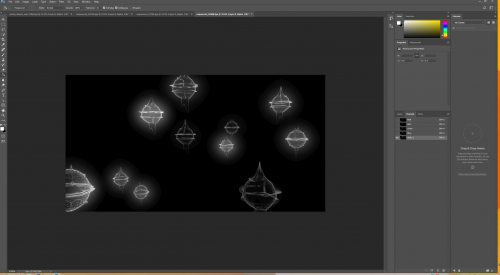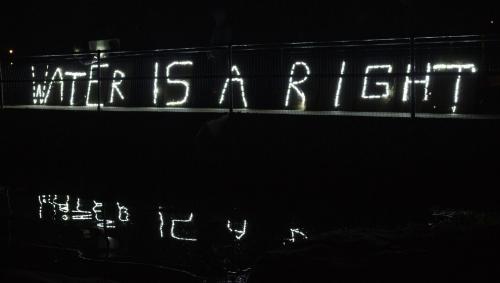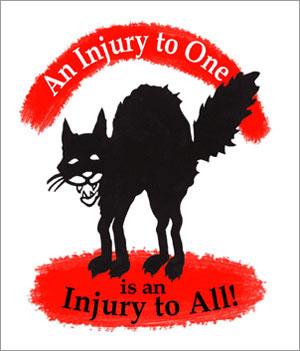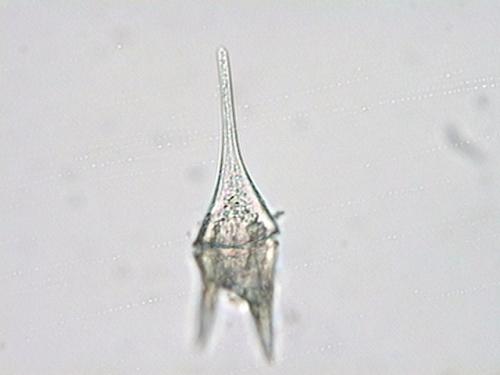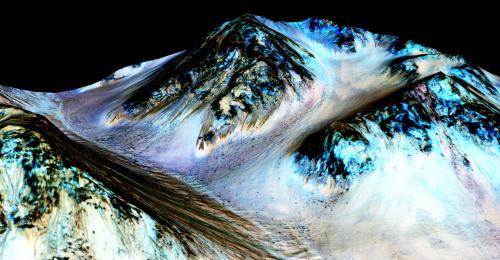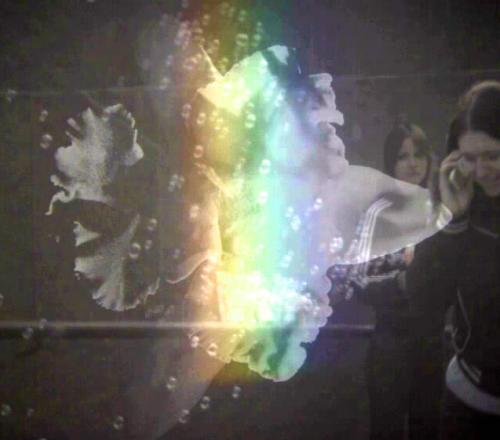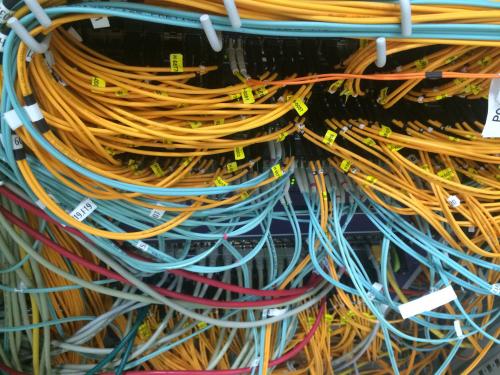BC: Since your current artistic research and practice is desert based, perhaps we could begin with the question of site, situation, and situatedness. The desert is a temporally entangled signifier. There is the desert as ghost of an earth as it used to be – green, teeming with life, covered by water, whose traces are seen by scientists as they navigate through its alien life and rocks that don’t seem to belong in place. Then there is the desert as the visage of a future earth to come, ravaged by aridity, lost to excruciating heat. Then there is the desert as the barren other even in the present, an extreme environment that is somehow conditioned by rules that are qualitatively different from the rules that apply to urban or rural life. I wonder whether these entangled temporalities have a specific role to play for your artistic practice in the desert?
SMW: This is a question with many layers. Site and situatedness is something that is very important in a very basic way: by relating to a place and this place in various lived and experienced timeslots you also have different layers like the layers of the earth. But at the same moment each of these layers and time space singularities is marked by its intentionalities and possibilities. Actually as we are talking about the practice and form of life of an artist I would like to connect these thoughts about sites and situations right away to the art of paying attention and to make relations in an ethical way but let’s go slowly. As more as you explore the details and dynamics of a material or a geographical place as well as a code, it can imply the richer in a sensual and in a conceptual way. So a first step in my practice is a layering of these temporalities that you describe for example to be felt and enfolded in whatever ways possible, whatever narrations you need: you smell a past you feel a presence while you focus on analyzing a sediment of its past. But in what Édouard Glissant calls a trembling of the world you can also experience the collapsing of some temporalities and maybe also their evolving. In political and also in metaphorical terms the desert is very vibrant. So even if it’s connected to death right away for me it carries the illusion, stubbornness and endurance as well as a very special ecosystem that connects the temporalities.
Comparable to some of the algae I am fascinated with I see drifting as a crucial method for the navigation between the temporalities of the desert and in juxtaposing and sharing the survival strategies: there is a community between rocks, sands and worms in their situatedness. You can even decode its social structure if you are meeting some of the personalities (but it’s too easy to slip into anthropocentrism). There are life and non-life stories connected.
The tiny fishbone structure of a sand like desert is indescribable if for example you are in the area of Salton Sea where the salivation and desertification is immediately felt. Like the Aral Sea it has inspired and triggered a lot of activists and artists work considering ecosystems and their dynamics with exploitation by humans. So visiting Bombay Beach for example and places outside the small town was like a trembling without consciousness in the usual sense. When I first stepped out of the vehicle that brought me there it felt like a time travel to what seems to be one geography with many layers. Taking this into my work, I try to make a walkable question: what is the stable sculptural texture of a certain form but with its situatedness?
You walk on a carpet and the cracking became soft but the closer you look at the pattern of the texture of the soft carpet you discover its fishbone depiction. This interests me beyond questioning representation but going to that power of the dynamic that lies beneath. I have carried the experience cracking-bones-under-my-feet-while walking, not being able to be weightless. These images I had with me for two years without knowing what to do till I found a way to translate this into another form and temporality within an installation where it had its own artificial ecosystem in the museum and another very situated space for the exhibition: The Henie Onstad Kunstsenter which is known for avant-garde music post-1960s and an ice princess collection palace for modernity, where I left most of the space empty filling it with sound and fishbone carpet as well as a CGI animation and microscopic called up prints of microorganisms that can collectively glow but also bear the potential of a deadly toxicity.
BC: Linked to the question of entangled temporalities is the predominant synchronizing temporal concept of our time, which is the Anthropocene. Here we have a geological temporality that is self-referential – even solipsistic – in its synchronistic impulse as a form to which all other temporalities, such as cultural, technological, and historical, must belong. The anthropocentrism of the Anthropocene, which is how things come to be constituted within a human referential domain – including objects as they are distributed in time that may be pre-human or post-human – offers a conceptual challenge to how alternatives to human ways of being may be conceived. For instance, one can specifically turn to the anti-humanism of the poststructuralists such as Foucault and their possible consequence of fluidity and openness, and how the primacy of the Anthropocene may be a return to a unifying signifier for the anthropic domain. Now the function of art, as I understand it, has been to imagine a space between the referential and the non-referential or the experiencable and the inexperiencable, and perhaps even – to quote Nagel – what it might be like to be a bat.[1]
How would you think about your own artistic engagements in relation to the self-referentiality of the Anthropocene and the brief – to a certain extent only symbolic – gestures opened up by anti-humanism?
SMW: To imagine what it might be like to be a bat was one of the key essays when I started studying artificial intelligence. However, I now see this also in relation to the question of justice and respect, to accept and be kin with the inseparable other while this is difficult in times of fascism and racism. Like you say the Anthropocene could be an overall framework but it is just a name if it does not imply a certain agency and responsibility for artists and poets likewise. They are surely the ones that drift and shift between the temporalities. That however implies they can bring diversity and shed light to dark corners as well. They are the ones that can tell stories while drifting especially because of these temporalities. In a funny way I find the terms humanist and post-humanist or anti-humanist very limited and I see our times as the ones with the advantage of let’s say having the possibilities to imagine what it is like to be a bat maybe because we only create more dark space and don’t know how to navigate so we should learn from the bats. Like Gayatri Chakravorty Spivak reminds us of the imperative to keep the imagination flexible.
In fact not only as a positive sign there is a lot of agency in toxic algae, zika and bacteria eating electrons. Maybe the human ego is just limited in the framework, like the Gaia hypothesis states as well.
BC: There is perhaps one genre that directly speaks to the question of agency and the non-human, and that is science fiction. I say this because science fiction continually invokes the non-human – or to quote a famous story by Walter M. Miller, “conditionally human”[2]– in framing the problems of human society and life. Science fiction deals with the question of the continuum of the life largely through a presentation of other species, be those extraplanetary aliens or species that exist on the planet. In spite of many peaceful first contact scenarios, far more prevalent is the deep-rooted suspicion and horror of other life, which stems from a form of decentering of the human that began with the origins of science fiction itself in works such as Fontenelle’s Entretiens sur la pluralité des mondes (1686) proposing that ours may not be the dominant species in the universe. This most iconic of this old genealogy especially in the filmic imagination are the “Big Bug” films of the 1950s, whose legacies are ubiquitous even at present. When we place this old genealogy in the new bottle of multispecies ethnography, I have the feeling that to a certain extent agency is recrafting the grotesquerie of coexistence with forces over which we have limited or no control, for instance microbial forms of life, which you just spoke about. This modern psychomachia, where positive (for instance healthy gut bacteria) or negative (for instance ebola) effects are both experienced on human body as a kind of canvas. Could you tell us a bit more about how you deal with the problem of other life in your own work?
SMW: It’s the joy of other life and cohabitation but also the respect that interests me. There is a dependence within the ecosystem and the social system. A dependence on the “the other” and exactly the “it’s not part of your control what the other is”. It might be toxic or it might be holy… Looking back into why science fiction has been influencing my work (or even has been entangled in its production as a better way of putting it) I remember one of my first installations in art school was maybe a bit clumsy referencing Ghost in the Shell the Manga (1989/1990), and another one in a student exhibition at the Fridericianum, which has this amazing round shaped strange architecture, was inspired by World on a Wire – Rainer Werner Fassbinders 1973 science fiction opus that also formally blurred simulation and reality. For the performance I had very oddly casted emo teenagers on real wires connected. So it was absolutely not what you expected and rather my very own material interpretation of the TV production that had bothered and inspired me also for its politics and social reality in my Franconian perception of the time at the end of the early 2000s. Important also in later works like Pattern recognition (an installation and exhibition in San Franscisco which referred to the same titled novel by William Gibson from 2003) was the attempt to materialize a metaphor and a sensibility super much based in the perception of reality and even an endeavor of changing it through poetry, science fiction, and art.
Returning to the role that critters and bacteria play in my work and the target of your question I see the beauty connected to this effect of potentiality that is necessarily ambiguous. Like in my recent installation Glistening troubles the phenomena of bioluminescence is the main focus. As a biological occurrence it has features that are still beyond human understanding and it has developed more and more toxic variations (it’s based on a protein reaction). In ancient times even being connected to a weapon against colonization when indigenous rituals worshipped the glow of the water in the bay. Some of the ancient rituals were used to unsuccessfully fight against the Spanish arrivals. Later in the 1960s the research has been fueled by the military as it promised to be a navigation system (which it has been forever for local fishermen) but to boost it into a military asset some work needed to be done. Most of it was dropped after a while but it funded also the research around it for example in some marine biology departments in California.
In many ways the other minds and bodies have to have single cell or multitudes threatening and awesome features. I cannot compete with the broad knowledge of science fiction literature reference but most important to me have been Ursula K Le Guin and Octavia E Butler. In both I read an awe for other life but including a mayhem of alienation and that is also what for an artist is prevailing and strong to express in other forms of three-dimensional or imaginative material. What can be a canvas is CGI in my practice at the moment and also drawing in many ways, transforming. These tools now have an intrinsic technologisation (including biohacking for example) in their use that needs to be neutralized so to say. But here I can go on for weeks…
BC: Yet another level at which science fiction links with our discussion so far is the question of climate change. Science fiction has borne a number of names, for instance ecofiction, eco-sf, cli-fi, anthropocene fiction etc, to visualize the impact of anthropogenic climate change in the range of possibilities. My larger problem with Amitav Ghosh’s argument in The Great Derangement[3] is that perhaps what he labels as “literary fiction”, tinged with the flavors of realism and historical fiction, are insufficiently pliant to accommodate scenarios of possibility, which only a genre positioned towards the future can, and thus he has been looking at the wrong place. Not only in literature, artists have often positioned their own work that considers the impact of climate change in terms of the futurist impulse of science fictionality, because it is the horizon of the future where utopias and dystopias may be accommodated. I would like to know if science fictionality – or the mode of seeing possibilities, in particular how things are seen to change and evolve in future times – has any relevance to your work as it accommodates utopian/dystopian impulses.
SMW: Very poignant and as we recognize there is a of wave of interest in science fiction recently broader than before which I think is related. After the capitalist critique in the 1990s that had to accept the depression and helplessness of its realism an energy of dystopia flooded cultural production. The movies Snowpiercer (2013) and The Hunger Games (2012) are a sort of remnants of this recent increased interest for science fiction. For Frederic Jameson and others this has the connection to a certain perception and political sensibility that I have appreciated since my time as a philosophy student for example in Donna Haraways work which connects political endeavor and the ecofiction as well as the dystopia as a “tool”. The octopus and the brittlestar as well as the dinoflaggelate have no problem with the mind body gap nor the nature culture divide that causes so much of our systemic violence getting reproduced. So in a way its an epistemological interest and a curiosity that drives me – learning from and paying attention to other systems of knowledge: cosmological, indigenous, inter generational knowledge as well as what we can sense and map from other species. Especially concerning communication and infrastructure, the key assets in digital culture, this seems to fuel into narrations and speculations. But as I am not a fiction writer unfortunately, other means of triggering attentions with spotlight at materials and lifeforms is what I am using in my installations. Now more than ever there is possibility as so much of promised progress has proved wrong and climate change has challenges that urge the search of new tools for transformation in a cosmological and microbiological perspective. NASA has just published amazing satellite photos of algae bloom stuck in huge parts of ice, creating a kind of canvas and a state of transformation that we have never witnessed before. Transformations in nature or biology are a huge trigger for my imagination based in reality with a bitter and even toxic anger that affects the skin. Even science might again have more riddles than before but that is a place for science fictionality and “science art-fiction”.
... beginning of a longer conversation to be published soon...
Bodhisattva Chattopadhyay works on science fiction, and he is especially interested in the scientific bases for projecting possible futures. He is the editor of the forthcoming anthology of global science fiction All Borders are Temporary (Transnational Arts Production, Oslo) and Indian Genre Fiction: Pasts and Future Histories (Routledge 2018). He is Editor in Chief of Fafnir: Nordic Journal of Science Fiction and Fantasy Research. Susanne M. Winterling and Bodhisattva Chattopadhyay together with Goutam Ghosh formed a group to work on Speculation: Desert, an ongoing project that has its first stage with Khoj: Maps and Prototypes of Science Fictional Presences
Footnotes
- ^ Thomas Nagel, What Is It Like to Be a Bat?, in : The Philosophical Review, Vol. 83, No. 4 (Oct., 1974), pp. 435-450 (https://warwick.ac.uk/fac/cross_fac/iatl/activities/modules/ugmodules/humananimalstudies/lectures/32/nagel_bat.pdf)
- ^ Walter Michael Miller, Conditionally Human, 2016.
- ^ Amitav Ghosh, The Great Derangement: Climate Change and the Unthinkable, Berlin 2016.
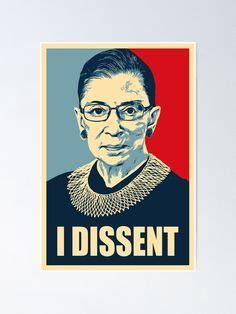
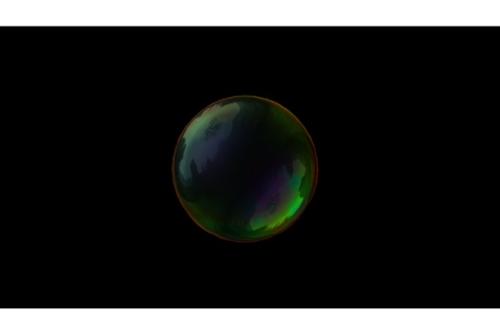
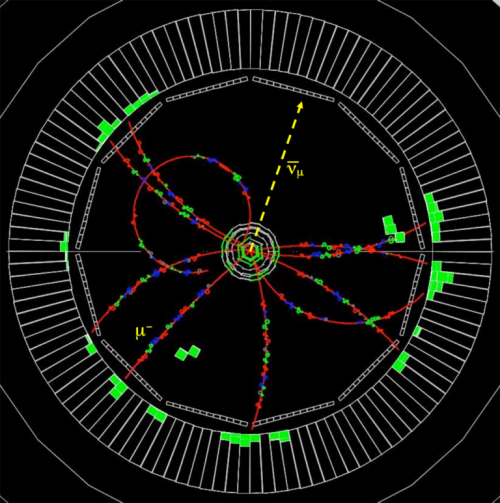
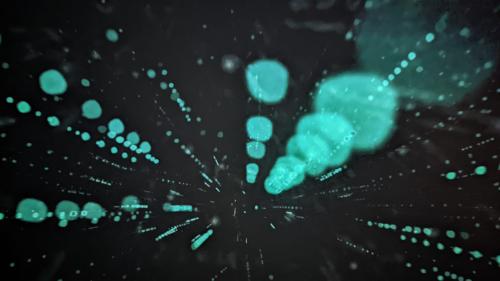
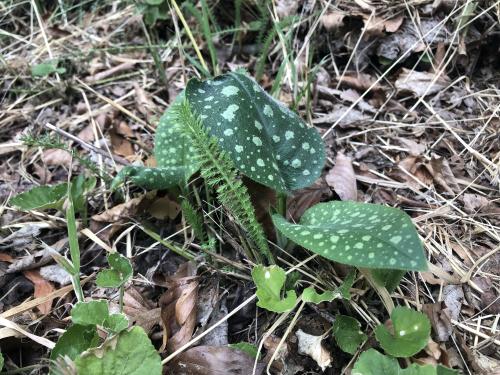
![Blackwash [working title]](/sites/default/files/styles/medium/public/56fe8ebf-7f16-4486-a251-6d85b1e906c3_4_5005_c.jpeg?itok=rIFeYRMo)
